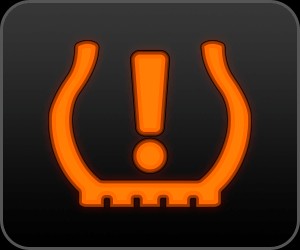Driving along, you might suddenly notice an unfamiliar symbol light up on your car’s dashboard. Among the array of icons, one that often causes confusion is the exclamation mark. Understanding what this symbol, and others, mean is crucial for maintaining your vehicle and ensuring your safety on the road. As automotive experts at cars.edu.vn, we’re here to clarify the meaning behind these vital warning lights, focusing specifically on the exclamation mark and its various contexts within your vehicle.
One of the most common appearances of an exclamation mark on your dashboard is the Tire Pressure Warning Light. This symbol typically looks like a horseshoe shape with an exclamation point inside.
This light indicates that one or more of your tires are significantly underinflated. Maintaining proper tire pressure is not just about fuel efficiency; it’s critical for safe handling, braking, and tire longevity. When you see this exclamation mark, it’s important to:
- Check your tire pressures: Use a tire pressure gauge to check the pressure of each tire.
- Inflate your tires: Inflate your tires to the recommended pressure listed on the sticker inside your driver’s side doorjamb or in your owner’s manual.
- Check for leaks: If the light comes back on shortly after inflation, you may have a leak or puncture in one of your tires.
While the tire pressure light is the most frequent association of an exclamation mark with car warnings, it’s not the only one. It’s important to remember that warning lights can vary slightly between car manufacturers, and your vehicle’s manual is always the definitive guide.
Beyond tire pressure, other warning lights can sometimes incorporate or be easily confused with an exclamation mark. Let’s look at some other common dashboard symbols to ensure you’re well-informed:
Antilock Brake System (ABS) Warning Light:
This symbol, displaying “ABS” within a circle, indicates an issue with your Antilock Braking System. While your regular brakes will still function, the ABS, which prevents wheel lock-up during hard braking, may be compromised. It’s advisable to have this checked by a professional technician promptly to ensure optimal braking performance, especially in emergency situations.
Engine Temperature Warning Light:
This light, often depicted as a thermometer-like symbol or a key above wavy lines, signals that your engine is overheating. This is a serious warning that needs immediate attention to prevent engine damage. If you see this light:
- Safely pull over: Stop your vehicle as soon as it is safe to do so.
- Turn off the engine: Let the engine cool down. Do not attempt to remove the radiator cap while the engine is hot.
- Check coolant levels: Once cooled, check your coolant levels. Low coolant is a common cause of overheating.
- Seek professional help: If the overheating persists, or if you are unsure of the cause, have your vehicle inspected by a mechanic.
Lamp Out Warning Light:
Often resembling a sun-like symbol, this light indicates that one of your exterior lights, such as a headlight, taillight, or brake light, is not functioning correctly. Operating your vehicle with a faulty light is not only illegal in many places but also dangerous, especially during nighttime or in adverse weather conditions. Check all your exterior lights and replace any bulbs that have burned out.
Understanding Your Vehicle is Key
While we’ve highlighted some common warning lights, including the tire pressure light with its exclamation mark symbol, it’s crucial to remember that your vehicle’s owner’s manual is your most reliable resource. It contains detailed information about all the warning lights specific to your car model and provides guidance on what actions to take when they illuminate.
Ignoring dashboard warning lights can lead to more significant vehicle problems and potentially compromise your safety. By understanding what these symbols, especially the exclamation mark in its various forms, are trying to tell you, you can take proactive steps to maintain your vehicle and drive with greater confidence and safety. When in doubt, always consult your owner’s manual or a qualified mechanic.
